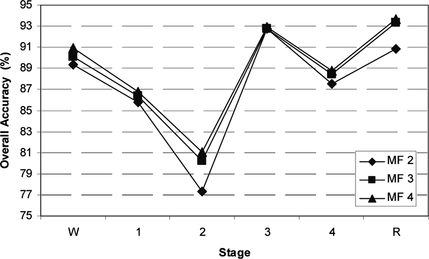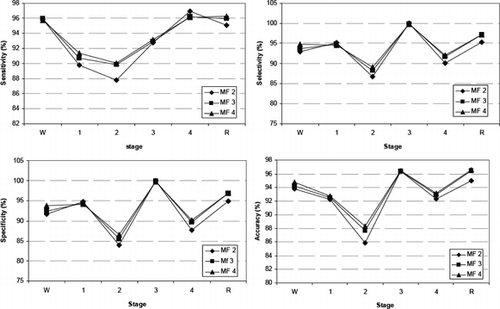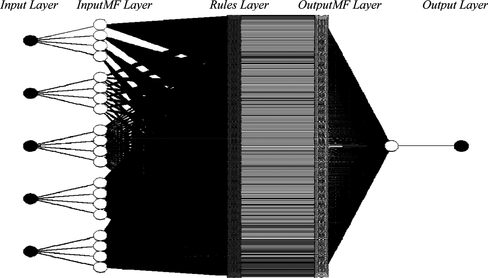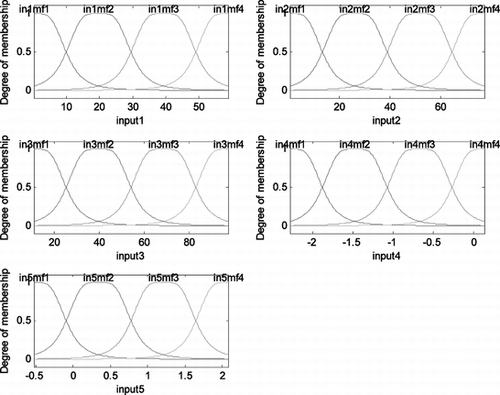Abstract
A new system for sleep multistage level scoring by employing extracted features from twenty five polysomnographic recording is presented. For the new system, an adaptive neuro-fuzzy inference system (ANFIS) is developed for each sleep stage. Initially, three types of electrophysiological signals including electroencephalogram (EEG), electrooculogram (EOG), and electromyogram (EMG) were collected from twenty five healthy subjects. The input pattern used for training the ANFIS subsystem is a set of extracted features based on the entropy measure which characterize the recorded signals. Finally an output selection subsystem is utilized to provide the appropriate sleep stage according to the ANFIS stage subsystems outputs. The developed system was able to provide an acceptable estimation for six sleep stages with an average accuracy of about 76.43% which confirmed its ability for multistage sleep level scoring based on the extracted features from the EEG, EOG and EMG signals compared to other approaches.
INTRODUCTION
Rechtschaffen and Kale (R&K) (Citation1968) recommendation (or standard) classifies the human sleep into two main stages: rapid eye movement (REM) and non-rapid eye movement (NREM). They further divide the NREM stage into various stages including stage one, two, three, and four (S1, S2, S3, and S4), respectively. R&K presented different rules to determine the stage of human sleep. These rules are based on the characteristics of electrophysiological signals including electroencephalogram (EEG), electrooculogram (EOG), and electromyogram (EMG). The main characteristics of the EEG signal are alpha, beta, theta, delta, sleep spindles, and K-complex. These characteristics are categorized based on different frequency bands and amplitudes. If the alpha wave presents more than half of the studied window, it indicates that the human is not sleeping and the state is classified as wakefulness state (W). Stage one is characterized by low voltage, mixed frequency EEG without rapid eye movement. Stage two is defined by the presence of the K-complex signal along with sleep spindle. If delta waves are present in less than half of the epoch, stage three is reported; where as if delta waves are present in more than half of the studied window, then stage four is defined.
Sleep stage scoring is the process of applying R&K rules on a recorded electrophysiological signal in order to identify the stage of sleep the human is currently passing. This classification is important in studying sleep disorders. The manual process of sleep stage scoring is done based on 30-second epochs, where sleep specialists use R&K rules to determine the sleep stage of each epoch. This manual procedure is time consuming and subjective, thus leading to high inter-agreement errors between specialists during the scoring procedure (Japan Sleep Society Citation1999).
The process of automatic sleep-stage scoring involves two main steps; the first step is extracting different features from the electrophysiological signals that characterize the human sleep. These features usually indicate the presence of different signals such as K-complex, sleep spindle, alpha, and beta waves. Before extracting the features, different smoothing and filtering techniques are applied (Hanaoka, Kobayashi, and Yamazaki Citation2002). Many features were extracted using frequency domain analysis such as the spectral power of frequency bands (Fell et al. Citation1996; Ferri et al. Citation2001). Other methods involve the usage of time domain analysis (Japan Sleep Society Citation1999). Recent works applied Wavelet approach using the time-frequency domain analysis (Oropesa, Cycon, and Jobert Citation1999; Kiymika, Akin, and Subas 2004; Liu, Zhang, and Yang Citation2002; Fraiwan, Khaswaneh, and Lweesy Citation2009). The second step is the process of applying different classification techniques to identify the sleep stage. Wide range of classification techniques were used, such as linear discriminate analysis (Molinari, Dumermuth, and Lange Citation1984), neural networks (Schaltenbrand, Lengelle, and Macher Citation1993; Schaltenbrand et al. Citation1996; Roberts and Tarassenko Citation1992; Shimada, Shiina, and Saito Citation1998; Lalitha and Eswaran Citation2007; Tagluk, Sezgin, and Akin Citation2009; Kurt et al. Citation2009; Vuckovic et al. Citation2002; Acir and Guzelis Citation2004; Fraiwan, Khaswaneh, and Lweesy Citation2009), Neuro-Fuzzy logic (Pohl and Fahr Citation1995; Yildiz et al. Citation2009), tree classification (Kubat, Pfurtscheller, and Flotzinger Citation1994; Fraiwan, Khaswaneh, and Lweesy Citation2009), Hidden Markov Models (Flexer et al. Citation2000; Flexer and Dorffner Citation2002), and case-based reasoning approach (Park et al. Citation2000). Table provides an illustration of the available state of the art systems reported in literature for sleep stage detection.
TABLE 1 Available Systems Reported in Literature for Sleep Stage Detection
In this article, an automated sleep multistage level classification model is developed using an adaptive neuro-fuzzy inference subsystem (ANFIS) for each sleep stage. Each subsystem combines the fuzzy logic system expert knowledge with the neural networks learning abilities to exploit its functionality based on the ANFIS structure. Each ANFIS subsystem is trained with features extracted from EEG, EMG, and EOG signals to determine its corresponding stage; W, 1, 2, 3, 4, or R, corresponding to wake, sleep stages: one, two, three, four and REM, respectively. The final estimated sleep stage from all subsystems is determined through an output selector subsystem. The latter combines all results from all subsystems and provides the best classification for the applied features. To achieve higher sensitivity and accuracy in sleep multistage classification, the system employs a parallel architecture, where each level corresponds to one sleep stage subsystem.
SYSTEM ARCHITECTURE
To sustain a high sensitivity and accuracy for all sleep stages, parallel system architecture is proposed as shown in Figure .
Signal Processing Unit
Training data by feeding the collected patients' data (EEG, EOG, and EMG) to a signal processing unit. The extracted features from the signal-processing unit are used to train the ANFIS subsystem models for each sleep stage. The generated model is used to classify further sleep stages after training. The signals features are extracted from five electrophysiological channels. These five channels are allocated as follows, two EEG channels, the left and right eye EOG channels, and the chin EMG channel. Each of the signals recordings are divided into time segments of 30 seconds. Figure shows different recorded epochs corresponding to sleep stages: W, 1, 2, 3, 4, and R, respectively.
FIGURE 2 Different recorded EEG, EOG, and EMG epochs corresponding to sleep stages: a – W, b – 1, c – 2, d – 3, e – 4, and f – R.

The signals from the two EEG channels are recorded using C3A2 and C4A1 electrodes. Features are extracted from both EEG channels based on the frequency range as shown in Table . Each feature represents the corresponding activity in the EEG signal: alpha wave, beta wave, theta wave, delta wave, K-complexes, and sleep spindles. The features calculation is carried out using the power spectrum estimation method of the EEG's 30-second time segment. The power spectrum estimation method is based on computing the power spectral density (PSD) using the Periodogram (Stoica and Moses Citation1997). The power spectral density S x (f) of a random time signal x(t) can be calculated as (Stoica and Moses Citation1997; Jackson Citation1989):
TABLE 2 Frequency Range for EEG Events and Waves
The correlation coefficient between the left and the right EOG are calculated to detect the state of the EOG. Furthermore, the total relative power for the ranges of [0.15–0.45] Hz, and [0.5–1.2] Hz are computed as well. The tone of the chin (EMG) is extracted as another feature, which can be exploited to differentiate between the REM and the wake stage. The EMG tone is evaluated by dividing the EMG signal into sub-epochs, each one has half second duration. The average of variances of the sub-epochs is then estimated.
A features selection process comes normally as the last step before the classification procedure. Some features may be redundant and tend to degrade the accuracy of the classification procedure; therefore, a features selection procedure is implemented. The gain ratio entropy approach is used for input features selection. The gain ratio is evaluated by measuring the gain ratio with respect to the class as (Witten and Frank Citation2000):
TABLE 3 Ranked Attributes Based on Entropy
ANFIS Subsystem Stages Model
The proposed new system is based on a parallel architecture. Each sleep stage is modeled by an Adaptive Nero-Fuzzy Inference System (ANFIS), which corresponds to one level of the parallel architecture. Such system combines the fuzzy logic system expert knowledge with the neural networks learning abilities to exploit its functionality (Jang Citation1993). The ANFIS architecture of each sleep stage consists of five-layered feedforward neural network, as shown in Figure . These five layers implement a Sugeno fuzzy expert system (TSK) of the following form (Jang Citation1993):
The input layer provides the subsystem with the extracted features. Layer 1 is an adaptive fuzzification layer. The output of each node Equation (Equation6) represents the matching degree with its membership function (μ Ai ), that corresponds to a linguistic label A i (e.g.: small, medium, or large) for the given input (x i ) (Jang Citation1993).
Training ANFIS Subsystems
During the training phase, each ANFIS subsystem tunes the entire premise and the consequent modifiable parameters for the adaptive nodes, such that the ANFIS minimizes the error between the structure output and a predefined training dataset. This set contains inputs/output pairs of the desired network behavior provided to the system by an expert. These parameters are initially generated by grid partitioning for the input space based on the numbers of the inputs of each subsystem and the membership functions (Jang Citation1993). For this purpose, a hybrid training algorithm is used, which combines the least square method with the gradient descent method (Jang Citation1993). The least square method is used to tune the consequent modifiable parameters during the forward pass while the gradient descent method is used to tune the premise modifiable parameters during the backward pass (Jang Citation1993). The ANFIS features for each stage subsystem are shown in Table . For instance, the membership functions for the five inputs of the stage-W subsystem after training are shown in Fig. with the universe of discourse for each input.
TABLE 4 Features for the ANFIS Subsystem Structure for Each Stage
Output Selection Subsystem
The automatic sleep stage level scoring is achieved according to the ANFIS stage subsystems output, which satisfies the following criterion:
EXPERIMENTAL RESULTS AND DISCUSSION
To evaluate the performance of the new proposed system, experiments are performed on 25 digital polysomnographic recordings. These recordings were collected from adult subjects with suspected sleep-disordered breathing. Subjects were randomly selected over a 6-month period (September 2002 to February 2003) from patients referred to the Sleep Disorders Clinic at St. Vincent's University Hospital, Dublin, for possible diagnosis of obstructive sleep apnea, central sleep apnea, or primary snoring (Goldberger et al. Citation2000). Subjects had to be above 18 years of age, with no known cardiac disease, no autonomic dysfunction, and they could not have been on medication known to interfere with heart rate (Goldberger et al. Citation2000).
Polysomnograms signals were collected using the Jaeger-Toennies system (Goldberger et al. Citation2000). Signals used are: EEG (C3-A2), left EOG, right EOG, and submental EMG.
For the all 25 subjects, sleep stages are scored by the same experienced sleep technologist according to standard R&K rules. Fifteen recordings are used for training the model and the rest ten recordings are used for system evaluation after training (Goldberger et al. Citation2000). The set of the first fifteen recordings was used for training the sleep stage ANFIS subsystem. The same training set was also used to obtain the optimal number of membership functions to represent the universe of discourse for each extracted feature to achieve an acceptable generalization for the developed system. For this purpose, a thorough study is conducted on the training data based on the performance of the proposed system upon the following statistical indices (Kiymik, Akin, and Subasi Citation2004; Yildiz et al. Citation2009; Lalitha and Eswaran Citation2007):
FIGURE 6 Overall accuracy using two, three, and four membership functions (MF) to represent the input features.

FIGURE 7 Sensitivity, selectivity, specificity and accuracy for sleep stages subsystems using two, three and four membership functions (MF) to represent the input features.

TABLE 5 The Performance of the System Using Two Membership Functions
TABLE 6 The Performance of the System Using Three Membership Functions
TABLE 7 The Performance of the System Using Four Membership Functions
To sustain the subsystems generalization for each sleep stage, the number of membership functions is not increased further. In such case, the ratio between the set of training data to the set of modifiable parameters for each ANFIS subsystem decreases and affects the generalization of the developed system. This is due to notable increase in ANFIS modifiable parameters.
After training, a set of 10 recordings is utilized for system evaluation, the same statistical indices: sensitivity, selectivity, specificity, and accuracy are used during this phase. The results obtained from this phase are tabulated in Table . As it can be analyzed from the table and after comparing with experts knowledge, the developed system is able to provide an acceptable estimation for all sleep stages with average percentage accuracy close to 76.43%, and an average percentage sensitivity of just about 90.02%.
TABLE 8 The Performance of the System
The results of the new developed system are compared to other available systems reported in literature for sleep stage detection, as shown in Table . The system that has been developed in (Tagluk, Sezgin, and Akin Citation2009) is based on a multilayer artificial neural network (ANN) for sleep stage estimation, stages: 1, 2, 3, 4, and REM using EEG, EMG, and EOG signals. The system was able to provide an average percentage accuracy of 74.7% after training. Comparing the new developed system output with R&K rules (Rechtschaffen and Kales Citation1968; Tagluk, Sezgin, and Akin Citation2009; Watanabe and Watanabe Citation2004), it shows an acceptable performance and agreement for 70.5% wakefulness, 38.3% REM and 82.6% NREM stages an average percentage of 63.8%. When comparing the new developed system response with classification method for automated sleep stage scoring based on a single EEG recording using wavelet packet decomposition (Watanabe and Watanabe Citation2004), this approach was able to achieve an average accuracy about 74% during testing phase. Therefore, the new developed system based on parallel ANFIS subsystems is able to improve the accuracy by combining the fuzzy logic system expert knowledge with the neural networks learning abilities to exploit its functionality.
CONCLUSION
This article presents an efficient, automated, online approach for sleep multistage level scoring employing extracted features form polysomnographic recording. For the new system, an adaptive neuro-fuzzy inference subsystem (ANFIS) is developed for each sleep stage by combining the fuzzy logic system expert knowledge with the neural networks learning abilities to utilize their functionalities.
The extracted features, which characterize the electrophysiological signals including electroencephalogram (EEG), electrooculogram (EOG), and electromyogram (EMG), were fed into each stage of the ANFIS subsystem as the input pattern for training and evaluating the new approach. The interesting performance for the new automated approach compared with other proposed approaches, confirmed its ability for online multistage sleep level scoring based on the extracted features form the EEG, EOG, and EMG signals.
REFERENCES
- Acir , N. , and C. Guzelis . 2004 . Automatic recognition of sleep spindles in EEG by using artificial neural networks . Expert Systems with Applications 27 ( 3 ): 451 – 458 .
- Fell , J. , J. Roschke , K. Mann , and C. Schaffner . 1996 . Discrimination of sleep stages: A comparison between spectral and nonlinear EEG measures . Electroencephalography and Clinical Neurophysiology 98 ( 5 ): 401 – 410 .
- Ferri , R. , F. Cosentinob , M. Eliab , S. Musumecib , R. Marinigc , and P. Bergonzic . 2001 . Relationship between delta, sigma, beta, and gamma EEG bands at REM sleep onset and REM sleep end . Clinical Neurophysiology 112 ( 11 ): 2046 – 2052 .
- Flexer , A. , and G. Dorffner . 2002 . An automatic, continuous and probabilistic sleep stager based on a hidden markov model . Applied Artificial Intelligence 16 ( 3 ): 199 – 207 .
- Flexer , A. , G. Gruber , and G. Dorffner . 2005 . A reliable probabilistic sleep stager based on a single EEG signal . Artificial Intelligence in Medicine 33 ( 3 ): 199 – 207 .
- Flexer , A. , P. Sykacek , I. Rezek , and G. Dorffner . 2000. Using hidden Markov models to build an automatic, continuous and probabilistic sleep stager. In Proceedings of the IEEE-INNS-ENNS International Joint Conference on Neural Networks, IJCNN 2000: 627–631.
- Fraiwan , L. , N. Khaswaneh , and K. Lweesy . 2009 . Automatic Sleep Stage Scoring with Wavelet Packets Based on Single EEG Recording . In Proceedings of World Academy of Science, Engineering and Technology 54 : 485 – 488 .
- Goldberger , A. , L. Amaral , L. Glass , J. Hausdorff , P. Ivanov , R. Mark , J. Mietus , G. Moody , C.-K. Peng , and H. Stanley . 2000 . PhysioBank, PhysioToolkit, and PhysioNet: Components of a new research resource for complex physiologic signals . Circulation 101 : e215 – e220 .
- Hanaoka , M. , M. Kobayashi , and H. Yamazaki . 2002 . Automatic sleep stage scoring based on waveform recognition method and decision-tree learning . Systems and Computers in Japan 33 ( 11 ): 1 – 13 .
- Jackson , L. 1989 . Digital Filters and Signal Processing, ed , 2nd . Norwell , MA , USA : Kluwer Academic Publishers .
- Jang , J.-S. 1993 . ANFIS: Adaptive-network-based fuzzy inference system . IEEE Transactions on Systems, Man and Cybernetics 23 ( 3 ): 665 – 685 .
- Japan Sleep Society . 1999 . Computer Comm., PSG Chart for Training.
- Kiymik , M. , M. Akin , and A. Subasi . 2004 . Automatic recognition of alertness level by using wavelet transform and artificial neural network . Journal of Neuroscience Methods 139 ( 2 ): 231 – 240
- Kubat , M. , G. Pfurtscheller , and D. Flotzinger . 1994 . AI-based approach to automatic sleep classification . Biological Cybernetics 70 ( 5 ): 443 – 448 .
- Kurt , M. , N. Sezgin , M. Akin , G. Kirbas , and M. Bayram . 2009 . The ANN-based computing of drowsy level . Expert Systems with Applications 36 ( 2 ): 2534 – 2542 .
- Lalitha , V. , and C. Eswaran . 2007 . Automated detection of anesthetic depth levels using chaotic features with Artificial Neural Networks . Journal of Medical Systems 31 ( 6 ): 445 – 452 .
- Liu , H. S. , T. Zhang , and F. S. Yang . 2002 . A multistage, multimethod approach for automatic detection and classification of Epileptiform EEG . IEEE Transactions on Biomedical Engineering 49 ( 12 ): 1557 – 1566 .
- Louis , R. P. , J. Lee , and R. Stephenson . 2004 . Design and validation of a computer-based sleep-scoring algorithm . Journal of Neuroscience Methods 133 ( 1–2 ): 71 – 80 .
- Molinari , L. , G. Dumermuth , and B. Lange . 1984 . EEG-based multivariate statistical analysis of sleep stages . Neuropsychobiology 11 ( 2 ): 140 – 148 .
- Oropesa , E. , H. L. Cycon , and M. Jobert . 1999 . Sleep Staging Classification using Wavelet Transform and Neural Network. Technical Report TR-99-008, International Computer Science Institute, Berkeley, California.
- Park , H. , J. Oh , D. Jeong , and K. Park . 2000 . Automated sleep stage scoring using hybrid rule- and case-based reasoning . Computers and Biomedical Research 33 ( 5 ): 330 – 349 .
- Pinero , P. , P. Garcia , L. Arco , A. Alvarez , M. Garcia , and R. Bonal . 2004 . Sleep stage classification using fuzzy sets and machine learning techniques . Neurocomputing 58 – 60 : 1137–1143 .
- Pohl , V. , and E. Fahr . 1995 . Neuro-fuzzy recognition of K-complexes in sleep EEG signals . In IEEE 17th Annual Conference Engineering in Medicine and Biology Society , 789 – 790 . Montreal , Quebec , Canada .
- Quinlan , J. 1993 . C4.5: Programs for Machine Learning . San Mateo , CA : Morgan Kaufmann .
- Rechtschaffen , A. , and A. Kales . 1968 . A manual of standardized terminology, techniques and scoring system for sleep stages of human subjects . Washington , DC : Public Health Service, US Government Printing Office .
- Roberts , S. , and L. Tarassenko . 1992 . Analysis of the sleep EEG using a multilayer network with spatial organization . IEEE Proceedings of Radar and Signal Processing 139 ( 6 ): 420 – 425 .
- Saastamoinen , A. , E. Huupponen , A. Värri , J. Hasan , and S. Himanen . 2006 . Computer program for automated sleep depth estimation . Computer Methods and Programs in Biomedicine 82 ( 1 ): 58 – 66 .
- Schaltenbrand , N. , R. Lengelle , and J. Macher . 1993 . Neural network model: application to automatic analysis of human sleep . Computers and Biomedical Research 26 ( 2 ): 157 – 171 .
- Schaltenbrand , N. , R. Lengelle , M. Toussaint , R. Luthringer , G. Carelli , A. Jacqmin , E. Lainey , A. Muzet , and J. P. Macher . 1996 . Sleep stage scoring using the neural network model: Comparison between visual and automatic analysis in normal subject and patients . Sleep 19 ( 1 ): 26 – 35 .
- Shimada , T. , T. Shiina , and Y. Saito . 1998 . Sleep stage diagnosis system with neural network analysis. In Proceedings of the 20th Annual International Conference of the IEEE Engineering in Medicine and Biology Society 4: 2074–2077 . Upper Saddle River , NJ , USA .
- Stoica , P. , and R. Moses . 1997. Introduction to Spectral Analysis . Prentice-Hall.
- Šušmáková , K. , and A. Krakovská . 2008 . Discrimination ability of individual measures used in sleep stages classification . Artificial Intelligence in Medicine 44 ( 3 ): 261 – 277 .
- Tagluk , M. , N. Sezgin , and M. Akin . 2009 . Estimation of sleep stages by an Artificial Neural Network Employing EEG, EMG and EOG . Journal of Medical Systems 34 ( 4 ): 717 – 725 .
- Vuckovic , A. , V. Radivojevic , A. Chen , and D. Popovic . 2002 . Automatic recognition of alertness and drowsiness from EEG by an artificial neural network . Medical Engineering & Physics 24 ( 5 ): 349 – 360 .
- Watanabe , T. , and K. Watanabe . 2004 . Noncontact method for sleep stage estimation . IEEE Transactions on Biomedical Engineering 51 ( 10 ): 1735 – 1748 .
- Witten , I. H. , and E. Frank . 2000 . Data mining: Practical machine learning tools and techniques with Java implementations . London , UK : Academic Press .
- Yildiz , A. , M. Akin , M. Poyraz , and G. Kirbas . 2009 . Application of adaptive neuro-fuzzy inference system for vigilance level estimation by using wavelet-entropy feature extraction . Expert Systems with Applications 36 ( 4 ): 7390 – 7399 .
- Zoubek , L. , S. Charbonnier , S. Lesecq , A. Buguet , and F. Chapotot . 2007 . Feature selection for sleep/wake stages classification using data driven methods . Biomedical Signal Processing and Control 2 ( 3 ): 171 – 179 .



